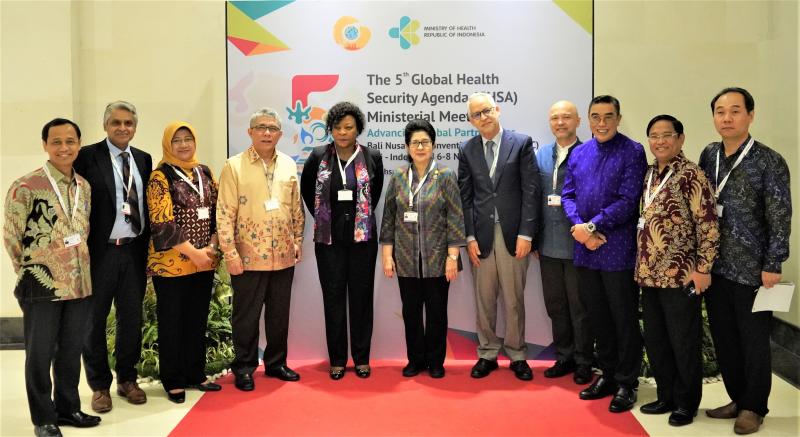
“Collective Actions for Effective Preparedness” side event at the 5th Global Health Security Agenda (GHSA) Ministerial Meeting in Bali, Indonesia.
November 6, 2018
South-East Asia Region
Indonesia
Bali, Indonesia
[[{"fid":"2360","view_mode":"default","fields":{"format":"default","alignment":"center","field_file_image_alt_text[und][0][value]":false,"field_file_image_title_text[und][0][value]":false,"external_url":""},"type":"media","field_deltas":{"1":{"format":"default","alignment":"center","field_file_image_alt_text[und][0][value]":false,"field_file_image_title_text[und][0][value]":false,"external_url":""}},"link_text":null,"attributes":{"width":"1000","style":"display: block; margin-left: auto; margin-right: auto;","class":"media-element file-default media-wysiwyg-align-center","data-delta":"1"}}]]
WHO worked to build on the current momentum for strengthening country health security capacities under IHR (2005) with a “Collective Actions for Effective Preparedness” side event at the 5th Global Health Security Agenda (GHSA) Ministerial Meeting in Bali, Indonesia.
The side event underscored the need to ensure technical and financial resources to support country implementation of National Action Plans for Heath Security (NAPHS). The side event, chaired by Indonesia Health Minister Nila Moeloek, was attended by most key GHSA members and helped set the tone for the overall GHSA conference by emphasizing the importance for national, regional and global health security of focusing on country implementation.
The 6 November side event featured the themes of Prioritization, Implementation, Monitoring Evaluation, and Accountability. Dr Jaouad Mahjour, director of the Country Health Emergency Preparedness and International Health Regulations (IHR) Department at WHO, said that NAPHS implementation is critical to build short and long-term capacities. WHO is supporting countries through efforts including a resource mapping tool that identifies the financial and technical resources available for activities to implement NAPHS. Dr Amara Jambai, chief medical officer of the Ministry of Health of Sierra Leone, described how his country is using the tool to chart donor and partner projects in the country, providing visibility for the partners’ investments while at the same time informing the government of Sierra Leone about where the gaps of unfunded activities exist.
Dr Frode Forland, director of infectious disease control and global health preparedness at the Norwegian Institute of Public Health, said a key priority is to ensure that countries are equipped with the technical expertise to implement their NAPHS. Dr Froland said Norway supports the Global Strategic Partnership Networks (GSPN), an initiative by the WHO Strategic Partnership for IHR and Health Security (SPH) to create a platform for multidisciplinary experts to provide technical assistance to countries for NAPHS implementation.
GSPN would involve experts from public health institutes/academia, non-state actors, and global/regional health security technical networks supporting countries through WHO coordination.
Dr Stella Chungong, chief of the Core Capacity Assessment, Monitoring and Evaluation Unit at WHO, said response to outbreaks is not enough. Preparedness is vital, she said, and is only possible by ensuring the most vulnerable populations have access to essential health services.
Countries cannot develop a public health preparedness plan on their own and must have access to the appropriate financial resources and technical assistance. Dr Chungong said health financing arrangements for NAPHS have to be led by national governments to effectively and comprehensively address population health needs before, during and after outbreaks and health emergencies.
The key to increased preparedness is a national multisectoral policy that focuses on sustained capacities for prevention, detection and management of any epidemic and outbreak in the communities, said Uganda Health Minister Jane Aceng. Dr Aceng said countries need risk-specific preparedness actions for community readiness, which requires long-term planning for sustainability and the resources to support implementation.
Mukesh Chawla, World Bank chief adviser for global health security, said Joint External Evaluations (JEEs) have helped counties to quantify gaps in health security capacities, and reflect the importance that countries have started to give to pandemic preparedness. However, despite obvious progress, this focus has not been accompanied by supporting increases in domestic or partner spending on strengthening public health capacities, he said, and as a result many countries are under-prepared for the next devastating epidemic. He said the World Bank, along with government and development partners, is hosting a discussion on how low-income countries can mobilize domestic and partner financing to strengthen capacities.
Dr Susan Corning, senior advisor to the deputy director general of the OIE, emphasized the tripartite strategic collaboration between WHO, FAI and OIE for global health security. The IHR-PVS bridging workshops, in which collaboration between the public health and animal health services in countries is analyzed and improved, provides a valuable example of working together.
H.J. Ormel, senior veterinary policy advisor for FAO, underscored the importance, while strengthening public health preparedness, of focusing on the key human-animal-ecosystem component of global health security.
Dr Mahjour closed the side event by noting that preparedness has a cost but should be considered an investment in health, safety and security. Funding should be aligned with costed preparedness plans that are based on assessments of risk and capacity, as well as on the prioritization of emergency preparedness measures.
The overall GHSA conference was designed to launch the GHSA 2024 Framework, which provides a high-level view of the context for GHSA’s goals and objectives for the coming five years. GHSA, working with partners, aims to “actively contribute to national, regional and global efforts to support countries in evaluation, planning, resource mobilization, and implementation of activities to build health security capacity so that, by 2024, more than 100 countries that have completed an evaluation of health security capacity will have undergone planning and resource mobilization to address gaps, and will be in the process of implementing activities to achieve impact.” The objective is that the countries will show improvement to a level of “Demonstrated Capacity” in at least five technical areas as measured by assessments such as the WHO IHR Monitoring and Evaluation Framework.